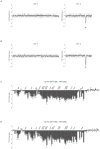Two regulators of Vibrio parahaemolyticus play important roles in enterotoxicity by controlling the expression of genes in the Vp-PAI region
- PMID: 20084267
- PMCID: PMC2800187
- DOI: 10.1371/journal.pone.0008678
Two regulators of Vibrio parahaemolyticus play important roles in enterotoxicity by controlling the expression of genes in the Vp-PAI region
Abstract
Vibrio parahaemolyticus is an important pathogen causing food-borne disease worldwide. An 80-kb pathogenicity island (Vp-PAI), which contains two tdh (thermostable direct hemolysin) genes and a set of genes for the type III secretion system (T3SS2), is closely related to the pathogenicity of this bacterium. However, the regulatory mechanisms of Vp-PAI's gene expression are poorly understood. Here we report that two novel ToxR-like transcriptional regulatory proteins (VtrA and VtrB) regulate the expression of the genes encoded within the Vp-PAI region, including those for TDH and T3SS2-related proteins. Expression of vtrB was under control of the VtrA, as vector-expressed vtrB was able to recover a functional protein secretory capacity for T3SS2, independent of VtrA. Moreover, these regulatory proteins were essential for T3SS2-dependent biological activities, such as in vitro cytotoxicity and in vivo enterotoxicity. Enterotoxic activities of vtrA and/or vtrB deletion strains derived from the wild-type strain were almost absent, showing fluid accumulation similar to non-infected control. Whole genome transcriptional profiling of vtrA or vtrB deletion strains revealed that the expression levels of over 60 genes were downregulated significantly in these deletion mutant strains and that such genes were almost exclusively located in the Vp-PAI region. These results strongly suggest that VtrA and VtrB are master regulators for virulence gene expression in the Vp-PAI and play critical roles in the pathogenicity of this bacterium.
Conflict of interest statement
Figures






Similar articles
-
The Xenogeneic Silencer Histone-Like Nucleoid-Structuring Protein Mediates the Temperature and Salinity-Dependent Regulation of the Type III Secretion System 2 in Vibrio parahaemolyticus.J Bacteriol. 2023 Jan 26;205(1):e0026622. doi: 10.1128/jb.00266-22. Epub 2022 Dec 5. J Bacteriol. 2023. PMID: 36468869 Free PMC article.
-
Vibrio parahaemolyticus VtrA is a membrane-bound regulator and is activated via oligomerization.PLoS One. 2017 Nov 17;12(11):e0187846. doi: 10.1371/journal.pone.0187846. eCollection 2017. PLoS One. 2017. PMID: 29149170 Free PMC article.
-
Role of the TPR family protein VPA1365 in regulating type III secretion system 2 and virulence in Vibrio parahaemolyticus.Appl Environ Microbiol. 2025 Apr 23;91(4):e0220124. doi: 10.1128/aem.02201-24. Epub 2025 Mar 25. Appl Environ Microbiol. 2025. PMID: 40130841 Free PMC article.
-
Advances on Vibrio parahaemolyticus research in the postgenomic era.Microbiol Immunol. 2020 Mar;64(3):167-181. doi: 10.1111/1348-0421.12767. Epub 2020 Jan 21. Microbiol Immunol. 2020. PMID: 31850542 Review.
-
Structure, function and regulation of the thermostable direct hemolysin (TDH) in pandemic Vibrio parahaemolyticus.Microb Pathog. 2018 Oct;123:242-245. doi: 10.1016/j.micpath.2018.07.021. Epub 2018 Jul 19. Microb Pathog. 2018. PMID: 30031890 Review.
Cited by
-
The role of type III secretion system 2 in Vibrio parahaemolyticus pathogenicity.J Microbiol. 2012 Oct;50(5):719-25. doi: 10.1007/s12275-012-2550-2. Epub 2012 Nov 4. J Microbiol. 2012. PMID: 23124738 Review.
-
The Vibrio parahaemolyticus ToxRS regulator is required for stress tolerance and colonization in a novel orogastric streptomycin-induced adult murine model.Infect Immun. 2012 May;80(5):1834-45. doi: 10.1128/IAI.06284-11. Epub 2012 Mar 5. Infect Immun. 2012. PMID: 22392925 Free PMC article.
-
Environmental magnesium ion affects global gene expression, motility, biofilm formation and virulence of Vibrio parahaemolyticus.Biofilm. 2024 Mar 28;7:100194. doi: 10.1016/j.bioflm.2024.100194. eCollection 2024 Jun. Biofilm. 2024. PMID: 38577556 Free PMC article.
-
CRISPR/Cas9 Screens Reveal Requirements for Host Cell Sulfation and Fucosylation in Bacterial Type III Secretion System-Mediated Cytotoxicity.Cell Host Microbe. 2016 Aug 10;20(2):226-37. doi: 10.1016/j.chom.2016.06.010. Epub 2016 Jul 21. Cell Host Microbe. 2016. PMID: 27453484 Free PMC article.
-
Characterization of V. cholerae T3SS-dependent cytotoxicity in cultured intestinal epithelial cells.Cell Microbiol. 2016 Dec;18(12):1857-1870. doi: 10.1111/cmi.12629. Epub 2016 Jul 22. Cell Microbiol. 2016. PMID: 27302486 Free PMC article.
References
-
- Blake PA, Weaver RE, Hollis DG. Diseases of humans (other than cholera) caused by vibrios. Annu Rev Microbiol. 1980;34:341–367. - PubMed
-
- Morris JG, Jr, Black RE. Cholera and other vibrioses in the United States. N Engl J Med. 1985;312:343–350. - PubMed
-
- Hlady WG, Klontz KC. The epidemiology of Vibrio infections in Florida, 1981–1993. J Infect Dis. 1996;173:1176–1183. - PubMed
-
- Daniels NA, MacKinnon L, Bishop R, Altekruse S, Ray B, et al. Vibrio parahaemolyticus infections in the United States, 1973–1998. J Infect Dis. 2000;181:1661–1666. - PubMed
Publication types
MeSH terms
Substances
LinkOut - more resources
Full Text Sources
Other Literature Sources
Molecular Biology Databases

